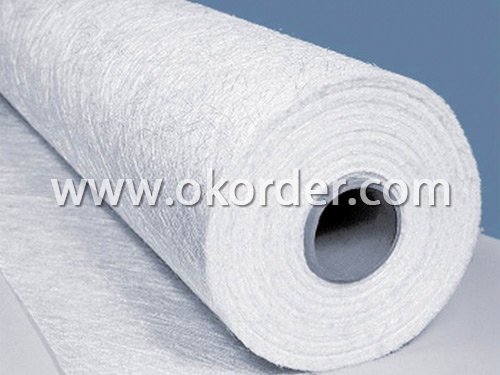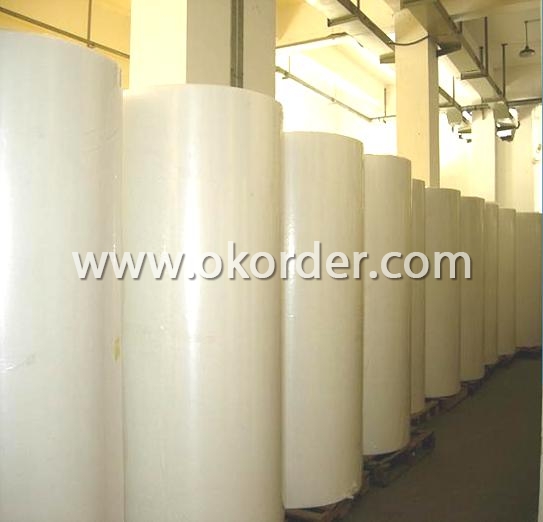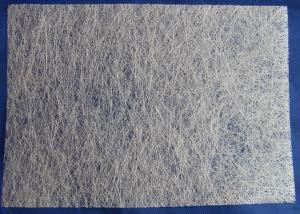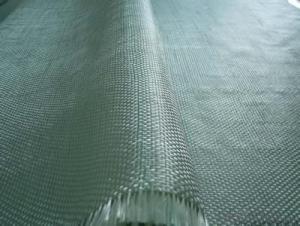High Quality Fiberglass Mat For Roofing
- Loading Port:
- Qingdao
- Payment Terms:
- TT or LC
- Min Order Qty:
- 10000 M2 m²
- Supply Capability:
- 50000000 M2 Per Year m²/month
OKorder Service Pledge
OKorder Financial Service
You Might Also Like
Introduction of High Quality Fiberglass Mat for Roofing:
The High Quality Fiberglass Mat for Roofing is usually used as substrates for water-proof roofing materials.It is an ideal substrate material for asphalt roofing rool and singles. The High Quality Fiberglass Mat for Roofing can also act as the lining for roof insulation layers to protect polyester foam insulation from the damaging effect caused by chemical solvent so as to prelong the lifetime.
Data Sheet of High Quality Fiberglass Mat for Roofing:
item | unit | FS90 | FS50 | FS60 | FS60-J30 | FS90-J30 |
linear density of yarn | tex | ----- | ----- | ---- | 34--58 | 34--68 |
space between yarns | mm | ----- | ------- | ----- | 30 | 30 |
area weight | g/m² | 90 | 50 | 60 | 60 | 90 |
bender content | % | 20 | 18 | 18 | 18 | 20 |
tensile strength MD | N/5cm | >330 | >220 | >230 | >260 | >360 |
tensile strength CMD | N/5cm | >260 | >150 | >170 | >160 | >240 |
wet strength | N/5cm | >98 | >60 | >63 | >63 | >988 |
width×length | m×m | 1.0×1500 | 1.0×2500 | 1.0×2000 | 1.0×2000 | 1.0×1500 |
Roll diameter | mm | <117 | <117 | <117 | <117 | <117 |
Specifications of High Quality Fiberglass Mat for Roofing:
High tensile strength:
corrosion and water resistance
easy satyration by bitumen
high porosity


- Q:How does fiberglass fabric perform in insulation against heat transfer?
- The exceptional performance of fiberglass fabric in heat transfer insulation can be attributed to its unique physical properties and composition. It is produced by weaving together fine strands of glass fibers to create a textile material. These glass fibers possess a high resistance to heat, effectively slowing down the conduction and convection of heat. The insulation properties of the fabric are further enhanced by its ability to trap air within its fibers. Due to its poor heat conducting abilities, air acts as an additional barrier against heat transfer when it is trapped in the fabric's air pockets. This property is commonly referred to as the fabric's thermal insulation or R-value. Furthermore, fiberglass fabric exhibits low thermal conductivity, meaning it does not easily absorb or transmit heat. This characteristic prevents heat transfer through the fabric, making it an ideal choice for insulation purposes. Additionally, fiberglass fabric is capable of withstanding high temperatures, making it suitable for applications that require heat insulation. It can endure temperatures of up to 1000 degrees Fahrenheit without experiencing degradation or loss of its insulating properties. In conclusion, the combination of fiberglass fabric's thermal resistance, low thermal conductivity, and air-trapping abilities make it highly effective in insulating against heat transfer. It finds extensive use in industries such as construction, automotive, aerospace, and manufacturing, where energy efficiency and safety require reliable thermal insulation.
- Q:What is the resolution of glass fiber cloth and polyester fiber cloth?
- Fiberglass cloth is also commonly called fiberglass geotextile. A geosynthetic material widely used in civil engineering.
- Q:Is fiberglass fabric suitable for aerospace applications?
- Yes, fiberglass fabric is suitable for aerospace applications. It is known for its lightweight, high strength, and excellent thermal resistance, making it ideal for various aerospace components such as aircraft interiors, insulation, and structural elements. Additionally, fiberglass fabric has good resistance to chemicals and fatigue, further enhancing its suitability for aerospace use.
- Q:Polyurethane waterproof coating how to use, polyurethane waterproof coating what are the methods of use?
- Clean the grass: with the shovel sticking on the leveling layer the gray skin removed, with a broom to clean the dust, especially the root canal, drain and drain and other parts should be carefully cleaned. In case of oil pollution, apply wire brush and sand paper to brush off, or paint with an adhesive paint on the surface of the grease. The surface must be smooth, and the concave place shall be made of 1: 3 cement mortar.
- Q:Are fiberglass fabrics available in different colors or finishes?
- Fiberglass fabrics come in various colors and finishes, offering a wide range of options. While the natural color of fiberglass fabric is typically white or off-white, it can be transformed through dyeing or coating processes to achieve diverse colors and finishes. Dyeing involves using specialized colorants that penetrate and bond with the fibers, resulting in vibrant and eye-catching hues. These colored fiberglass fabrics find extensive use in applications where aesthetics play a vital role, such as the manufacturing of clothing, home decor items, and automotive interiors. Moreover, fiberglass fabrics can also be coated with different finishes like silicone, acrylic, or polyurethane, which not only enhance their performance but also provide specific properties like water resistance, heat resistance, or chemical resistance. The availability of a variety of colors and finishes in fiberglass fabrics opens up countless opportunities for both creative and functional applications.
- Q:Can fiberglass fabric be used for making stage curtains?
- Stage curtains can indeed be made using fiberglass fabric, a versatile material that offers numerous advantages. One notable benefit is its lightweight and durable nature, making it both easy to handle and resistant to damage. For stage curtains, these qualities are crucial as they must endure frequent opening and closing during performances. Moreover, fiberglass fabric is flame retardant, ensuring the safety of both the stage and the performers. Additionally, it possesses excellent acoustic properties, effectively absorbing sound and enhancing the theater's acoustics. Furthermore, fiberglass fabric is available in various colors and can be easily painted or printed on, allowing for customization and artistic expression. In conclusion, due to its durability, fire resistance, acoustic properties, and aesthetic flexibility, fiberglass fabric is a suitable choice for creating stage curtains.
- Q:Can fiberglass fabric be used for heat shields?
- Yes, fiberglass fabric can be used for heat shields. Fiberglass is known for its excellent thermal insulation properties, making it an ideal material for heat shields. It can withstand high temperatures without deforming or melting, which is crucial for protecting sensitive equipment or structures from heat damage. Additionally, fiberglass fabric is also lightweight, flexible, and can be easily molded or cut into desired shapes, allowing for easy installation in various applications where heat protection is required.
- Q:What are the temperature resistance capabilities of fiberglass fabric?
- Fiberglass fabric has excellent temperature resistance capabilities, making it a popular choice for various industrial and commercial applications. It can withstand high temperatures up to 1000°C (1832°F) without any significant degradation in its mechanical or physical properties. This temperature resistance is due to the inherent properties of fiberglass, which is a composite material made from fine fibers of glass embedded in a matrix of resin or polymer. These fibers have a high melting point and can resist thermal degradation, allowing the fabric to maintain its structural integrity even under extreme heat conditions. Additionally, fiberglass fabric also exhibits good thermal insulation properties, which further enhances its temperature resistance capabilities. Overall, fiberglass fabric is well-suited for use in applications that involve exposure to high temperatures, such as insulation, fire protection, aerospace, automotive, and other industries.
- Q:What are the different thickness options for fiberglass fabric rolls?
- Fiberglass fabric rolls come in a variety of thickness options to suit different applications and requirements. The thickness of fiberglass fabric is typically measured in ounces per square yard (oz/yd²) or grams per square meter (g/m²). The most common thickness options for fiberglass fabric rolls range from 4 oz/yd² (135 g/m²) to 10 oz/yd² (340 g/m²). These mid-range options are suitable for a wide range of general-purpose applications, such as reinforcing composite materials, boat building, automotive repairs, and insulation. For lighter applications, there are thinner fiberglass fabric rolls available, usually ranging from 1 oz/yd² (34 g/m²) to 3 oz/yd² (102 g/m²). These lightweight options are commonly used for applications where weight is a concern, such as in the aerospace industry, model-making, and hobbyist projects. On the other hand, for more heavy-duty applications that require greater strength and durability, thicker fiberglass fabric rolls are available. These options typically range from 12 oz/yd² (408 g/m²) to 30 oz/yd² (1017 g/m²) or even higher. These thicker fiberglass fabrics are commonly used in industrial settings, such as for reinforcing concrete, manufacturing pipes, tanks, and other structural components. It's important to note that the specific thickness options can vary depending on the manufacturer and supplier. Additionally, some manufacturers may offer custom thickness options to meet specific project requirements. Therefore, it's always advisable to check with the supplier or manufacturer to determine the available thickness options for fiberglass fabric rolls.
- Q:Can fiberglass fabric be used for making boats?
- Yes, fiberglass fabric can be used for making boats.
1. Manufacturer Overview |
|
|---|---|
| Location | Shandong, China |
| Year Established | 1964 |
| Annual Output Value | Above US$ 20 Million |
| Main Markets | 20.00% North America 20.00% South America 10.00% Eastern Europe 10.00% Southeast Asia 10.00% Northern Europe 10.00% South Asia 10.00% Western Europe 5.00% Africa 5.00% Mid East |
| Company Certifications | ISO9001:2000 |
2. Manufacturer Certificates |
|
|---|---|
| a) Certification Name | |
| Range | |
| Reference | |
| Validity Period | |
3. Manufacturer Capability |
|
|---|---|
| a)Trade Capacity | |
| Nearest Port | Qingdao Port |
| Export Percentage | 31% - 40% |
| No.of Employees in Trade Department | 10-20 People |
| Language Spoken: | English; Chinese; |
| b)Factory Information | |
| Factory Size: | Above 200,000 square meters |
| No. of Production Lines | Above 10 |
| Contract Manufacturing | Design Service Offered; Buyer Label Offered |
| Product Price Range | High; Average |
Send your message to us
High Quality Fiberglass Mat For Roofing
- Loading Port:
- Qingdao
- Payment Terms:
- TT or LC
- Min Order Qty:
- 10000 M2 m²
- Supply Capability:
- 50000000 M2 Per Year m²/month
OKorder Service Pledge
OKorder Financial Service
Similar products
New products
Hot products
Hot Searches
Related keywords





























